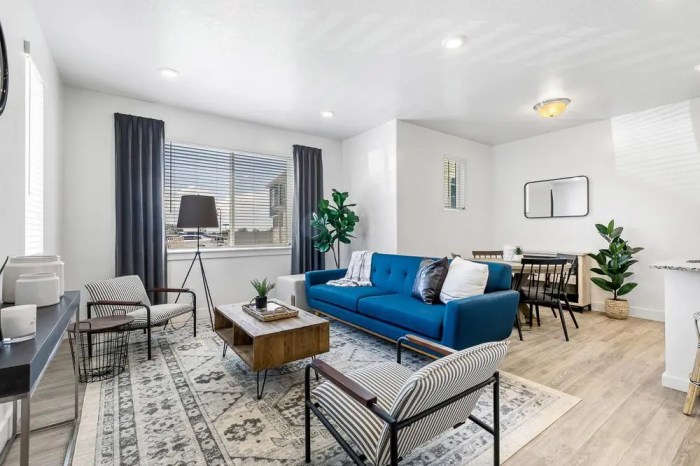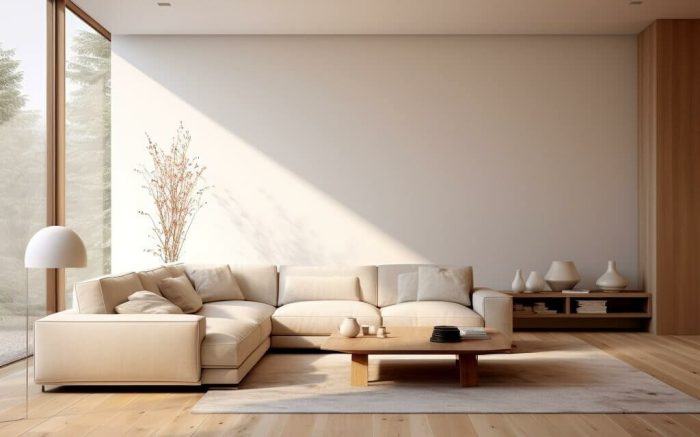Desain interior rumah minimalis terbaru – Minimalist interior design continues to be a popular choice for homeowners seeking a clean, uncluttered, and functional living space. This style prioritizes simplicity, functionality, and the intentional use of space, creating a calming and aesthetically pleasing environment. However, “minimalist” doesn’t mean boring! This article explores the latest trends in minimalist home interior design, offering a comprehensive guide to help you create your dream minimalist haven.
We’ll delve into color palettes, furniture choices, lighting solutions, and other key elements to achieve a modern and stylish minimalist aesthetic.

Source: visionaryhomes.com
Understanding the Core Principles of Minimalist Design
Before diving into the latest trends, it’s crucial to understand the core principles of minimalist design. These principles form the foundation upon which all stylistic choices are made. They are:
- Simplicity: Reduce clutter and extraneous items. Every object should serve a purpose.
- Functionality: Prioritize pieces that are both beautiful and practical.
- Clean Lines: Avoid overly ornate or fussy details. Straight lines and simple shapes are key.
- Neutral Color Palette: Focus on a limited range of calming colors, often whites, grays, beiges, and muted tones.
- Natural Light: Maximize natural light to create an airy and spacious feel.
- Decluttering: Regularly purge items you no longer need or use.
Latest Color Palettes for Minimalist Homes
While neutral tones are a staple in minimalist design, current trends are embracing subtle variations and unexpected accents. Instead of stark white, we’re seeing warmer whites, creamy off-whites, and soft greiges gaining popularity. These provide a more inviting and less sterile feel. Subtle color accents, like muted blues, greens, or dusty pinks, are used sparingly to add personality without compromising the overall minimalist aesthetic.
Think of a single statement piece of furniture or a carefully chosen piece of artwork in a complementary color.
Furniture Selection: Form and Function in Harmony
Minimalist furniture focuses on clean lines, simple shapes, and multi-functional pieces. Think sleek sofas with simple silhouettes, low-profile coffee tables, and storage ottomans that double as seating. Materials like natural wood, metal, and high-quality fabrics are favored for their durability and understated elegance. Avoid overly decorative or ornate furniture; choose pieces that are both aesthetically pleasing and practical.
Consider incorporating modular furniture, allowing for flexibility and adaptability as your needs change. The key is to select pieces that seamlessly integrate into the space without overwhelming it.
Lighting: Creating Ambiance and Functionality
Lighting plays a crucial role in setting the mood and functionality of a minimalist space. Natural light should be maximized through large windows and strategically placed mirrors. Artificial lighting should be layered, combining ambient, task, and accent lighting. Recessed lighting is a popular choice for providing even illumination, while floor lamps and table lamps add warmth and personality.
Consider incorporating smart lighting systems for customizable ambiance and energy efficiency. Dimmable lights are essential for creating different moods throughout the day.
Materials and Textures in Minimalist Design: Desain Interior Rumah Minimalis Terbaru
The choice of materials significantly impacts the overall feel of a minimalist space. Natural materials like wood, stone, and concrete add warmth and texture, while metallic accents add a touch of modern sophistication. The key is to use these materials sparingly and strategically. For instance, a concrete floor might be paired with light wood furniture and soft textiles to create a balanced and inviting space.
Avoid mixing too many different materials; stick to a cohesive palette to maintain a sense of calm and order.
Incorporating Plants and Greenery
Adding plants to a minimalist space can create a sense of life and vibrancy without compromising the overall aesthetic. Choose plants with simple, clean lines and avoid overly fussy varieties. Potted plants in neutral-colored pots or baskets can add visual interest and improve air quality. Larger plants can serve as statement pieces, while smaller plants can be grouped together to create a mini-garden.
Decluttering and Organization: Maintaining a Minimalist Lifestyle
Maintaining a minimalist aesthetic requires a commitment to decluttering and organization. Regularly purge items you no longer need or use, and find creative storage solutions to keep things tidy. Built-in storage, shelving units, and drawer organizers can help to maximize space and minimize clutter. The goal is to create a space that is both functional and aesthetically pleasing, free from visual distractions.
Modern Minimalist Kitchen Design
Minimalist kitchens are characterized by clean lines, sleek cabinetry, and integrated appliances. Neutral-colored countertops and backsplashes create a sense of calm, while open shelving displays carefully curated items. A large island serves as a focal point, providing ample workspace and storage. High-quality appliances are integrated seamlessly into the design, maintaining a streamlined look. Consider incorporating smart technology, such as smart refrigerators and ovens, for added convenience.
Minimalist Bathroom Design Ideas
Minimalist bathrooms prioritize functionality and clean lines. Sleek vanities with integrated sinks, minimalist faucets, and frameless shower enclosures create a spa-like atmosphere. Neutral-colored tiles and natural stone add warmth and texture, while strategically placed lighting enhances the space. Towel racks and storage units are integrated seamlessly into the design, minimizing clutter. Consider incorporating smart features, such as heated floors and towel racks, for added comfort.
Small Space Minimalist Design Solutions
Minimalist design is particularly well-suited to small spaces. By focusing on functionality and eliminating clutter, you can create a sense of spaciousness even in a limited area. Use mirrors strategically to reflect light and create the illusion of more space. Multi-functional furniture, such as a sofa bed or a coffee table with storage, maximizes space efficiency. Choose light-colored walls and floors to make the space feel larger and brighter.
Keep the color palette neutral to avoid overwhelming the space.

Source: redfin.com
Frequently Asked Questions (FAQ)
- Q: Is minimalist design expensive? A: Not necessarily. While high-quality materials can be costly, minimalist design emphasizes functionality over extravagance. By focusing on essential pieces and avoiding unnecessary purchases, you can create a stylish and functional space on a budget.
- Q: Is minimalist design boring? A: Not at all! Minimalist design focuses on creating a calm and inviting space through careful selection of materials, colors, and furniture. It allows for creativity and personality to shine through in subtle ways, such as through artwork or carefully chosen accessories.
- Q: How do I declutter for a minimalist lifestyle? A: Start by identifying items you no longer need or use. Donate, sell, or discard these items. Then, focus on organizing the remaining items to maximize space and minimize clutter. Consider using storage solutions to keep things tidy and out of sight.
- Q: What are some key elements of minimalist bedroom design? A: A minimalist bedroom prioritizes a calm and restful atmosphere. This is achieved through a neutral color palette, simple furniture, and minimal accessories. Focus on comfortable bedding and good-quality lighting.
Resources
Call to Action
Ready to transform your home into a minimalist haven? Contact us today to discuss your design needs and let us help you create the space of your dreams!
FAQ Corner
What are the key characteristics of minimalist interior design?
Clean lines, a neutral color palette, functional furniture, and a decluttered space are hallmarks of minimalist design.
How can I maximize natural light in a minimalist home?
Use light-colored walls and flooring, strategically place mirrors to reflect light, and incorporate large windows or skylights.
What are some popular materials used in minimalist interior design?
Natural materials like wood, stone, and concrete are frequently used, along with sleek metals and glass.
How do I incorporate personal touches without compromising the minimalist aesthetic?

Source: kyuhyungcho.com
Choose a few meaningful items that reflect your personality and display them thoughtfully, avoiding clutter.
Is minimalist design suitable for families with children?
Yes, with careful planning and the use of durable, easy-to-clean materials, minimalist design can work well for families.